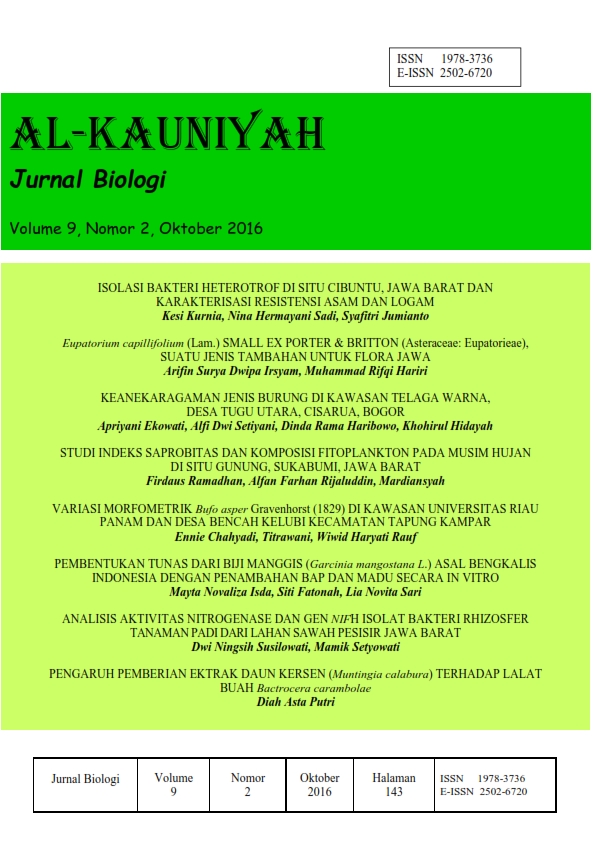PEMBENTUKAN TUNAS DARI BIJI MANGGIS (Garcinia mangostana L.) ASAL BENGKALIS DENGAN PENAMBAHAN BAP DAN MADU SECARA IN VITRO
DOI:
https://doi.org/10.15408/kauniyah.v9i2.3376Keywords:
BAP, Bengkalis, Induksi tunas, Madu, Honey, Shoot inductionAbstract
Abstrak
Garcinia mangostana L. merupakan salah satu spesies dari famili Guttiferae kaya senyawa dari golongan xanthon. Manggis memiliki juvenil yang lama. Salah satu metode yang dapat memecahkan masalah dalam perbanyakan tanaman manggis dalam jumlah yang banyak, bisa sepanjang musim dan menghasilkan tanaman yang seragam yaitu kultur in vitro. Tujuan dari penelitian ini adalah untuk menentukan konsentrasi terbaik antara Benzil Amino Purin (BAP) dan madu terhadap induksi tunas dari eksplan biji manggis yang belah tiga melintang secara in vitro. Penelitian ini menggunakan Rancangan Acak Lengkap (RAL) dengan perlakuan BAP (0;3 mg/L) dan madu (3;6 mg/L) pada media MS (Murashige-Skoog) dengan pengamatan 70 hari setelah tanam (hst). Hasil penelitian menunjukkan bahwa pemberian BAP maupun madu mampu meningkatkan pembentukan tunas. Pemberian BAP dan madu berpengaruh nyata terhadap persentase terbentuknya tunas, waktu muncul tunas, jumlah tunas dan panjang tunas. Jumlah tunas terbanyak terdapat pada perlakuan 3 mg/L BAP sebanyak 20 tunas per biji. Kombinasi perlakuan dengan penambahan 3 mg/L BAP + 3 ml/L madu menghasilkan persentase terbentuk tunas tertinggi (100%); waktu muncul tunas tercepat 12,75 hst; dan panjang tunas tertinggi 1,86 cm. Pada penelitian ini telah berhasil menginduksi tunas dari biji manggis yang dibelah tiga melintang asal Bengkalis dengan penambahan BAP dan madu.
Abstract
Garcinia mangostana L. is one of the species within the family Guttiferae that rich in compounds from the class of xanthon. Mangosteen has time juvenile problems. One method that can solve the problem in the mangosteen plant propagation which can be produced in a large number in all season and uniform is in vitro culture. The purpose of this study was to determine the best concentration of BAP and honey to induce the formation of shoot from explants of mangosteen seeds split transversely into three pieces by in vitro method. This study used a Completely Randomized Design (CRD) with a treatment of BAP (0;3 mg/L) and honey (3;6 mg/L) on MS medium with 70 days of observation. The results showed that the BAP and honey can improve the formation of shoots. The addition of BAP and honey significantly affected the percentage of the formed shoots, the period of shoots appear, the number of shoots and shoot length. The treatment of 3 mg/L BAP resulted in the most shoots formed as many as 20 shoots per seed. The combined treatment 3 mg/L BAP + 3 ml/L of honey produced 100% of the formed shoots; fastest period of shoots appear (12.75 DAS); and the longest shoot (1.86 cm). Therefore, the addition of BAP and honey to the three transversely-split mangosteen seeds from Bengkalis origin successfully induced the formation of the shoot.
References
Ajibola, A, Chamunorwa, J. P. & Erlwanger, K. H. (2012). Nutraceutical values of na-tural honey and its contribution to human health and wealth. Nutrition & Metabolism, 9 (61), 1-12.
Akter, S., Nasiruddin, K. M., & Khaldun, A. B. M. (2007). Organogenesis of Dendrobium orchid using traditional media and organic extracts. Jurnal of Agriculture and Rural Development, 5 (1&2), 30-35.
Al-Khateeb, A. A., (2008). Regulation of in vitro bud formation of date palm (Phoenix dactylifera l.) Cv. Khanezi by different carbon sources. Bioresource Technology, 99 (14), 6550-6555.
Bagde, A. B., Sawant, R. S., Bingare, S. D., Sawai, R. V., & Nikumbh, M. B. (2013). Therapeutic and nutritional values of honey (madhu). International Research Journal of Pharmacy, 4 (3), 19-22.
Bogdanov, S, T. Jurendic, R. Sieber, P. Gallmann. 2008. Honey for nutrition and health: a Review. American Journal of The College of Nutrition, 27, 677-689.
Departemen Pertanian. 2012. (2015 September 3). Retrived from http://database.deptan. go.id.
Harahap, F., Hasratuddin, & Suriani, C. (2012). Shoot growth of in vitro mangosteen (Garcinia mangostana l.) Results of benzyl adenine plant growth regulators and the different explants size. Saintika Journal, 12, 1-13.
Harahap, F., Poerwanto, P., Suharsono, Suriani, C., & Rahayu, S. (2014). In vitro growth and rooting of mangosteen (Garcinia mangostana l.) on medium with different concentration of plant growth regulator. HAYATI Journal of Biociences, 21 (4), 151-158.
Isda, M, N,, Fatonah, S., & Rahmawati, R. Y. (2015). Induksi tunas dari eksplan biji manggis (Garcinia mangostana L.) asal Bengkalis secara in vitro proceeding Semirata. Pontianak.
Joni, Y.Z., Efendi, D., & Roostika, I. (2014). Morfogenesis eksplan keping biji dari tiga klon manggis (Garcinia mangostana L.) pada tiga jenis media dasar. Journal Horticulture, 24 (2), 94-101.
Manyi-Loh, C. E., Clarke, A.M., & Ndip, R. N. (2011). An overview of honey: therapeutic properties and contribution in nutrition and human health. African Journal of Microbiology Research, 5 (8), 844-852.
Nugroho, A. E. (2013). Manggis (Garcinia mangostana L.): dari kulit buah yang terbuang hingga menjadi kandidat suatu obat [Bibliografi]. Fakultas Farmasi, Universitas Gadjah Mada. Yogyakarta.
Qosim, W. A. (2004). Pemuliaan manggis tak sesulit dibayangkan. (2015 September 7). Retrived from http://www.pikiran-rakyat.com/cetak/1204/cakrawala/lainnya4.html.
Roostika, I., Sumarlim, N., & Mariska, I. (2008). Micropropagation of mangosteen (Garcinia mangostana L.). Indonesian Journal of Agriculture, 1 (1), 28-33.
Sari, Y. P., Manurung, H., & Novita, V. (2011). Mikropropagasi tanaman anggrek tebu (Grammatophyllum speciosum bl.) secara in vitro dari sumber eksplan tunas pucuk pada media ms (Murashige-Skoog) dengan penambahan madu. Mulawarman Science, 10, 51-62.
Sirchi, M. H. T., Kadir, M. A., Aziz, M.A., Rashid, A. A., Rafat, A., & Javadi, M. B. (2008). Amelioration of mangosteen mikropropagation through leaf and seed segments (Garcinia mangostana L.). African Journal of Biotechnology, 7 (12), 2025-2029.
Tawaro, S., Suraninpong, P., & Chanprame, S. (2008). Germination and regeneration of Cymbidium findlaysonianum lindl. On a medium supplemented with some organic sources. Walailak Journal Science and Technology, 5 (2), 125-135.

